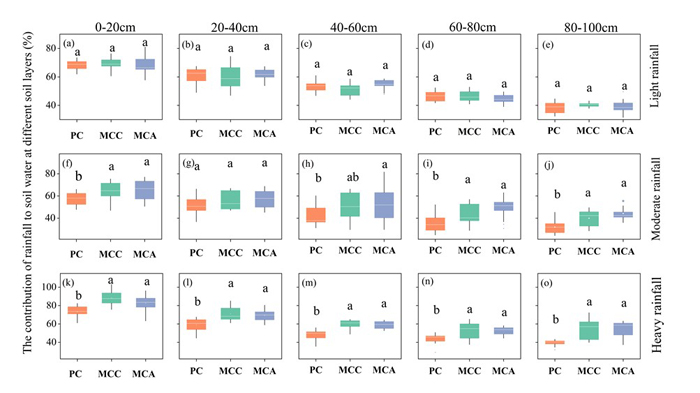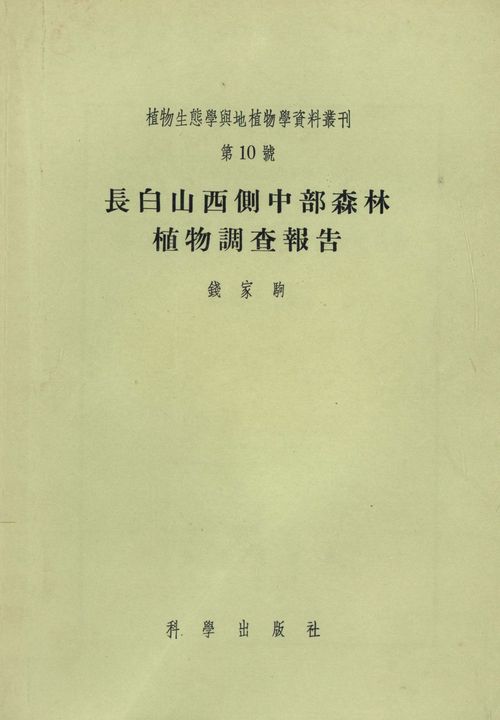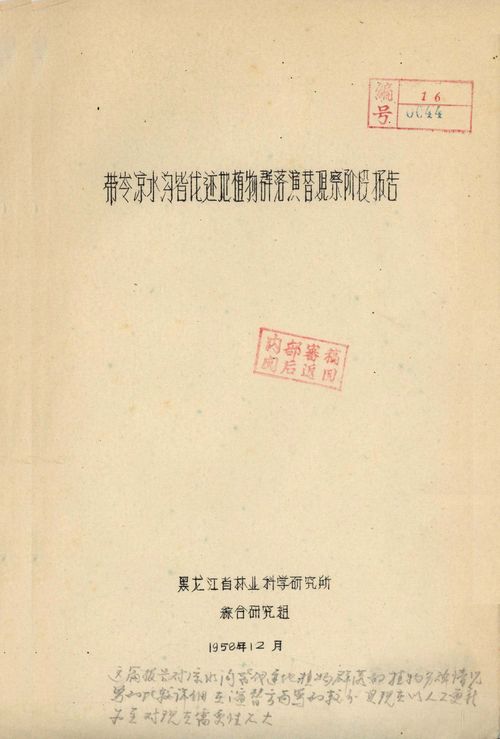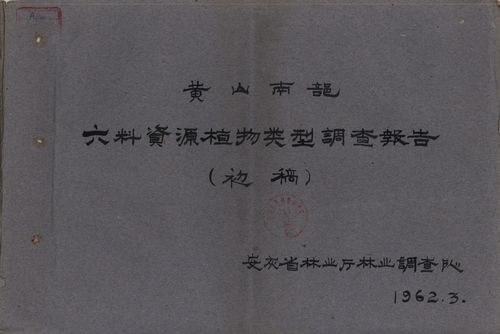
影响森林细根分解的腐生真菌功能特性研究综述
编号
lyqk009495


中文标题
影响森林细根分解的腐生真菌功能特性研究综述


作者单位
1. 绵阳师范学院城乡建设与规划学院,四川绵阳 621000;
2. 生态安全与保护四川省重点实验室,四川绵阳 621000


期刊名称
世界林业研究


年份
2021


卷号
34


期号
3


栏目名称
专题论述


中文摘要
森林细根分解是陆地生态系统养分循环的关键环节和重要过程,腐生真菌通过其特性广泛参与有机质分解、养分循环,连接植物与土壤2大碳库。环境和生物因素共同影响着腐生真菌生态功能的实现。文中综述了森林细根分解的腐生真菌功能特性、胞外酶特性、腐生真菌群落多样性变化、演替过程及影响因素,指出在后期研究中可利用高通量测序技术,深入开展腐生真菌胞外酶功能特性、营养策略、功能多样性组间协作研究,探索真菌主导的凋落物分解机制,并应用网络关系分析生境和底物异质性对腐生真菌群落结构和多样性、生态位划分、竞争或合作频率关系的影响,揭示细根分解的腐生真菌群落演替、聚集和驱动机制。


基金项目
国家自然科学基金“不同改造模式下柏木人工林凋落物生产与腐解特征”(32071747);四川省科技厅项目“雌雄沙棘与丛枝真菌共生对重金属污染的响应及联合修复效应”(2021YJ0293);绵阳市科技局项目“基于城市绿化废弃物无害化处理的绿色营养基生产研究”(17YFHB001);四川省教育厅应用基础与研究项目“柏木低效林改造引入树种细根分解真菌群落演替研究”(18ZB0305);绵阳师范学院高层次人才科研启动项目“林窗位置对腐生真菌群落聚集的影响”(QD2020A17)


英文标题
Review of Functional Characteristics of Saprophytic Fungi Affecting the Decomposition of Fine Roots in Forest Ecosystem


作者英文名
Li Dehui, Han Zhoulin, Wu Qinggui, Luo Guorong, Liang Mingxia, Chen Juan


单位英文名
1. School of Urban and Rural Planning and Construction, Mianyang Normal University, Mianyang 621000, Sichuan, China;
2. Ecological Security and Protection Key Laboratory of Sichuan Province, Mianyang 621000, Sichuan, China


英文摘要
The decomposition of fine roots in forest is the key part and important process of nutrient cycling in the terrestrial ecosystem. Saprophytic fungi are major ecological actors in organic substance decomposition and nutrient cycling and in connecting two carbon pools of plants and soils. Environmental and biological factors are jointly affecting the realization of ecological functions of saprophytic fungi. This paper reviews the saprophytic fungal functional characteristics, extracellular enzyme characteristics, and the community diversity, succession processes and influencing factors of saprophytic fungi during decomposition of forest fine roots. It is pointed that researchers could use high-throughput sequencing technology to carry out the research on the collaboration between saprophytic fungi extracellular enzyme functional characteristics, nutrition strategies and functional diversity, explore litter decomposition mechanism by fungi, and apply the ecological network analysis method to analyze the impact of different habitats and substrates on the relationship among structure and diversity, ecological niche division and competition or cooperation frequency of saprophytic fungi community, in order to reveal the mechanism of saprophytic fungal community succession, aggregation and driving in the process of fine root decomposition.


英文关键词
fine root decomposition;saprophytic fungi;community diversity;community succession;influencing factor


起始页码
25


截止页码
31


投稿时间
2020/7/28


最后修改时间
2020/12/4


作者简介
李德会,女,讲师,博士,研究方向为森林资源可持续经营管理,E-mail:15881601680@163.com


通讯作者介绍
陈娟,女,副教授,博士,研究方向为植物生态与环境修复,E-mail:cj-041698@163.com


E-mail
15881601680@163.com;cj-041698@163.com


分类号
S718.55


DOI
10.13348/j.cnki.sjlyyj.2020.0114.y


参考文献
[1] PREGIZER K S, DEFOREST J L, BURTON A J, et al. Fine root architecture of nine North American trees[J]. Ecological Monographs, 2002, 72(2):293-309.
[2] MCCORMACK L M , EISSENSTAT D M, PRASAD A M, et al. Regional scale patterns of fine root lifespan and turnover under current and future climate[J]. Global Change Biology, 2013, 19(6):1697-1708.
[3] STOKLAND J N. Wood decomposition[M]//STOKLAND J, SIITONEN J, JONSSON B. Biodiversity in dead wood(ecology, biodiversity and conservation). New York: Cambridge University Press, 2012: 10 − 28.
[4] OSONO T. Role of phyllosphere fungi of forest trees in the development of decomposer fungal communities and decomposition processes of leaf litter[J]. Canadian Journal of Microbiology, 2007, 52(8):701-716.
[5] ALLMER J, STENLID J, DAHLBERG A. Logging-residue extraction does not reduce the diversity of litter-layer saprotrophic fungi in three Swedish coniferous stands after 25 years[J]. Canadian Journal of Forest Research, 2009, 39(9):1737-1748.
[6] BALDRIAN P. Forest microbiome: diversity, complexity and dynamics[J]. FEMS Microbiology Reviews, 2017, 41(2):109-130.
[7] PURAHONG W, WUBET T, LENTENDU G, et al. Life in leaf litter: novel insights into community dynamics of bacteria and fungi during litter decomposition[J]. Molecular Ecology, 2016, 25(16):4059-4074.
[8] HAWKSWORTH D L. Global species numbers of fungi: are tropical studies and molecular approaches contributing to a more robust estimate?[J]. Biodiversity and Conservation, 2002, 21(9):2425-2433.
[9] CLEMMENSEN K E, FINLAY R D, DAHLBERG A, et al. Carbon sequestration is related to mycorrhizal fungal community shifts during longterm succession in boreal forests[J]. The New Phytologist, 2015, 205(4):1525-1536.
[10] LIERS C, BOBETH C, PECYNA M, et al. DyP-like preoxidases of the jelly fungus Auricularia auricula-judae oxidize nonphenolic lignin model compounds and high-redox potential dyes[J]. Applied Microbiology and Biotechnology, 2009, 85(6):1869-1879.
[11] KLEMM D, HEUBLEIN B, FINK H-F, et al. Cellulose: fascinating biopolymer and sustainable raw material[J]. Angewandte Chemie (International Edition), 2005, 22(44):3358-3393.
[12] EDWARDS I P, UPCHURCH R A, ZAK D R. Isolation of fungal cellobiohydrolase I genes from sporocarps and forest soils by PCR[J]. Applied and Environmental Microbiology, 2008, 74(11):3481-3489.
[13] MASTER E R, ZHENG Y, STORMS R, et al. A xyloglucan-specific family 12 glycosyl hydrolase from Aspergillus niger recombinant expression, purification and characterization[J]. Biochemical Journal, 2008, 411(1):161-170.
[14] BAUCHER M, RALPH J, BOERJAN W. Lignin biosynthesis[J]. Annual Review of Plant Biology, 2003, 54:519-546.
[15] HIGUCHI T. Look back over the studies of lignin biochemistry[J]. Journal of Wood Science, 2006, 52(1):2-8.
[16] LUNDELL T, MAKELA M R, HIDEN K. Lignin modifying enzymes in filamentous basidimmycetes: ecological, functional and phylogenetic review[J]. Journal of Basic Microbiology, 2010, 50(1):5-20.
[17] BALAJI V. Enzymatic demethylation of lignin for potential biobased polymer applications[J]. Fungal Biology Reviews, 2019, 33(3/4):190-224.
[18] KELLNER H, LUIS P, PECYNA M J, et al. Widespread occurrence of expressed fungal secretory peroxidases in forest soils[J]. Plos One, 2014, 9:e95557. DOI:10.1371/journal.pone.0095557
[19] RILEY R, SALAMOV A A, BROWN D W, et al. Extensive sampling of basidiomycete genomes demonstrates inadequacy of the white-rot/brown-rot paradigm for wood decay fungi[J]. Proceedings of the National Academy of Sciences of the United States of America, 2014, 111(27):9923-9928.
[20] HATAKKA A, HAMMEL K E. Fungal Biodegradation of Lignocelluloses[M]//HOFRICHTER M. Industrial applications: the mycota: a comprehensive treatise on fungi as experimental systems for basic and applied research. Berlin: Springer, 2010: 319 − 340.
[21] VORISKOVA J, BALDRIAN P. Fungal community on decomposing leaf litter undergoes rapid successional changes[J]. ISME Journal, 2013, 7(3):477-486.
[22] FUKASAWA Y, OSONO T, TAKEDA H. Dynamics of physicochemical properties andoccurrence of fungal fruit bodies during decomposition of coarse woody debris of Fagus crenata[J]. Journal of Forest Research, 2009, 14(1):20-29.
[23] SCHLATTER D C, KAHL K, CARLSON B, et al. Fungal community composition and diversity vary with soil depth and landscape position in a no-till wheat-based cropping system[J]. FEMS Microbiology Ecology, 2018, 94(7). DOI:10.1093/femsec/fiy098
[24] PELTONIEMI K, LAIHO R, JUOTTONEN H, et al. Microbial ecology in a future climate: effects of temperature and moisture on microbial communities of two boreal fens[J]. FEMS Microbiology Ecology, 2015, 91(7). DOI:10.1093/femsec/fiv062
[25] FUKASAWA Y, MATUOKA S. Communities of wood-inhabiting fungi in dead pine logs along a geographical gradient in Japan[J]. Fungal Ecology, 2015, 18:75-82.
[26] HOPPE B, PURAHONG W, WUBET T, et al. Linking molecular deadwood-inhabiting fungal diversity and community dynamics to ecosystem functions and processes in Central European forests[J]. Fungal Diversity, 2016, 77(1):367-379.
[27] ALZARHANI A K, CLARK D R, UNDERWOOD G J C, et al. Are drivers of root-associated fungal community structure context specific?[J]. The ISME Journal, 2019, 13(5):1330-1344.
[28] BRADFORD M A, WOOD S A, BARDGETT R D, et al. Contrasting primary successional trajectories of fungi and bacteria in retreating glacier soils[J]. Molecular Ecology, 2014, 23(2):481-497.
[29] RICE A V, TSUNEDA A, CURRAH R S. In vitro decomposition of Sphagnum by some microfungi resembles white rot of wood[J]. FEMS Microbiology Ecology, 2006, 56(3):372-82.
[30] KAHL T, ARDSTRAT T, BABER K, et al. Wood decay rates of 13 temperate tree species in relation to wood properties, enzyme activities and organismic diversities[J]. Forest Ecology and Management, 2017, 391:86-95.
[31] 吴晓晖, 谢永丽, RENATO D O, 等. 3株分离自高寒草甸根际芽孢杆菌的分子鉴定及其生物活性[J]. 草业科学,2017,34(12):2454-2463.
[32] 许秀兰, 杨春琳, 田莎, 等. 华山松凋落针叶上的真菌多样性及4株真菌的纤维素分解能力[J]. 林业科学,2016,52(1):80-88.
[33] YUAN J, ZHENG X F, CHENG F, et al. Fungal community structure of fallen pine and oak wood at different stages of decomposition in the Qinling Mountains, China[J]. Scientific Reports, 2017, 7:e13866. DOI:10.1038/s41598-017-14425-6
[34] BOER W D, FOLMAN L B, SUMMERBELL R C, et al. Living in a fungal world: impact of fungi on soil bacterial niche development[J]. FEMS Microbiology Reviews, 2005, 29(4):795-811.
[35] CHASE J M, MYERS J A. Disentangling the importance of ecological niches from stochastic processes across scales[J]. Philosophical Transactions of the Royal Society B (Biological Sciences), 2011, 366(1576):2351-2363.
[36] KIVLIN S N, WINSTON G C, GOULDEN M L, et al. Environmental filtering affects soil fungal community composition more than dispersal limitation at regional scales[J]. Fungal Ecology, 2014, 12:14-25.
[37] URBANOVA M, ?NAJDR J, BALDRIAN P. Composition of fungal and bacterial communities in forest litter and soil is largely determined by dominant trees[J]. Soil Biology and Biochemistry, 2015, 84:53-64.
[38] LI D H, LI X W, SU Y, et al. Forest gaps influence fungal community assembly in a weeping forest[J]. Applied Microbiology and Biotechnology, 2019, 103:3215-3224.
[39] JUMPPONEN A, JONES K L, BLAIR J. Vertical distribution of fungal communities in tallgrass prairie soil[J]. Mycologia, 2010, 102(5):1027-1041.
[40] ASEMANINEJAD A, THORN R G, BRAIN A, et al. Climate change favours specific fungal communities in boreal peatlands[J]. Soil Biology and Biochemistry, 2018, 120:28-36.
[41] SHE W W, BAI Y X, ZHANG Y Q, et al. Resource availability drives responses of soil microbial communities to short-term precipitation and nitrogen addition in a desert shrubland[J]. Frontiers in Microbiology, 2018:9. DOI:10.3389/fmicb.2018.00186
[42] LIU D, LIU G H, CHEN L, et al. Soil pH determines fungal diversity along an elevation gradient in Southwestern China[J]. Science China(Life Sciences), 2018, 61(6):718-726.
[43] ADAV S S, RAVINDRAN A, SZE S K. Quantitative proteomic study of Aspergillus fumigatus secretome revealed deamidation of secretory enzymes[J]. Journal of Proteomics, 2015, 24(119):154-168.
[44] MUSCOLO A, BAGNATO S, SIDARI M, et al. A review of the roles of forest canopy gaps[J]. Journal of Forestry Research, 2014, 25(4):725-736.
[45] 张明锦, 陈良华, 张健, 等. 马尾松人工林林窗内凋落叶微生物生物量碳和氮的动态变化[J]. 应用生态学报,2016,27(3):672-680.
[46] 周义贵, 郝凯婕, 李贤伟, 等. 林窗对米亚罗林区云杉低效林土壤有机碳和微生物生物量碳季节动态的影响[J]. 应用生态学报,2014,25(9):2469-2476.
[47] BRZOSTEK E R, FINZ A C. Substrate supply, fine roots, and temperature control proteolytic enzyme activity in temperate forest soils[J]. Ecology, 2011, 92(4):892-902.
[48] LI X Z, RUI J P, MAO Y J, et al. Dynamics of the bacterial community structure in the rhizosphere of a maize cultivar[J]. Soil Biology and Biochemistry, 2014, 68:392-401.
[49] FLOUDS D, BENTZER J, AHREN D, et al. Uncovering the hidden diversity of litter-decomposition mechanisms in mushroom-forming fungi[J/OL]. The ISME Journal.(2020)[2020-03-17]. https://doi.org/10.1038/s41396-020-0667-6.
[50] 公维丽. 整合功能组学方法研究重要丝状真菌生物质分解偏好性[D]. 济南: 山东大学, 2017.
[51] LUCKING R, HAWKSWORTH D L. Formal description of sequence-based voucherless fungi: promises and pitfalls, and how to resolve them[J]. IMA Fungus, 2018, 9(1):143-166.
[52] DENG Y, ZHANG P, QIN Y G, et al. Network succession reveals the importance of competition in response to emulsified vegetable oil amendment for uranium bioremediation[J]. Molecular Ecology, 2017, 18(1):205-218.
[53] NEWMAN M E. Modularity and community structure in networks[J]. Proceedings of the National Academy of Sciences of the Unites States of American, 2006, 103(23):8577-8582.


发布日期
2020-12-11


PDF全文
浏览全文


-
相关记录
更多
- 正交胶合木结构建筑发展现状及影响因素 2023
- 林木高径比研究综述 2023
- 热改性木材化学成分变化及其影响因素 2022
- 产业政策对林业产业结构优化影响研究进展 2022
- 中国干旱半干旱区土壤微生物分布特征及其影响因素 2022
- 国内外林地流转影响因素及成效研究进展 2022
 打印
打印







